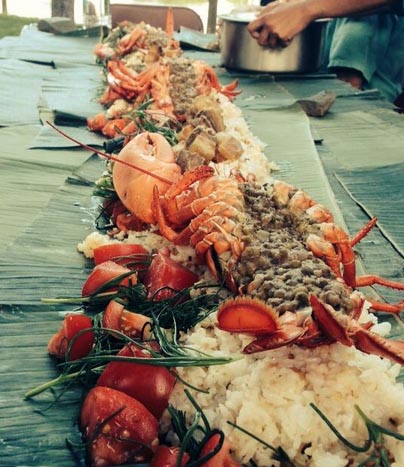Much has been written about restaurants like Qui, Pig and Khao, and Maharlika — Filipino restaurants in the US — and how they have been instrumental in promoting our cuisine.
But while their efforts have been recognized, there’s one young chef who has gone beyond just serving traditional Pinoy food. Her name is Yana Gilbuena and she’s a spirited self-trained chef currently on a 50-state kamayan-style food tour called the SALO project.
The Bacolod-born, Iloilo-raised, and New York-based 30-year-old missed Filipino food so much she used that as inspiration to host pop-up dinners across the states.

Yana Gilbuena
What is the SALO project and how did the tour come about?
When I was doing my SALO pop-ups in Brooklyn, I was already thinking how to make this a sustainable hobby because I discovered that it was really my passion: to cook authentic Filipino food, design a dining experience that is very different for people, and also connect people because guests who come to my dinners don’t know each other. So by the end of the meal, they become new friends.
At that time, no one was doing authentic Filipino food and serving it kamayan (to eat with bare hands). I was planning on doing a bi-coastal SALO each quarter, then I got laid off from my 9-5. So I took it as an opportunity to explore where SALO can go. I did a mini-tour in the west coast from Los Angeles, San Francisco, Seattle and then Vancouver. Then came back to New York and couldn’t imagine myself working for a company again.
And that’s when you decided to prolong the project and do more cities. What have been some of the challenges in setting up the tour?
So many! The challenges I face vary from state to state. For example, despite having a strong Filipino organization in Manhattan, Kansas, the turnout was one of the smallest ones to date. I’d say, the most common one would be finding a place to host me, setting up the dinner, and finding the diners. Another is finding contacts that are rooted in the food industry to validate and spread the word of the project. Press is great, but doesn’t necessarily guarantee a turnout based on readership. One state, North Dakota, I had a hard time finding all of the above, plus there was no Asian stores in the city that I chose (Bismarck), so I ended up serving the kamayan dinner on butcher paper [than on coconut leaves]. It still worked! Hey, it’s not the challenges that define one, it’s how you react and adapt to them.

No spoons and forks
Please share some of the most memorable things that happened in the tour thus far.
In Alaska, we took the ferry from Anchorage to Cordova, saw glaciers, met with the fisher couple (www.driftersfish.com) and saw their operation, learned about sustainable fishing practices in Alaska, and ate Alaskan oysters. In Sioux Fall, South Dakota, the reception of the Filipinos was so amazing and I was able to connect with the local chef and met such amazing supportive people. The last one that really warmed my heart was in Des Moines, Iowa. It was such a heavily sponsored SALO. The community really came together, from the farmers, to the chefs, to the press, to the locals. It was so beautiful that it was written up twice on the Des Moines Register.

Ginisang monggo with lobster
What are some of the most well-liked Filipino dishes in your fare?
Well, everybody loves pork, so sisig has been a big hit. So are lechon and lechon kawali. I made pinangat for SAVOR Filipino, a Filipino food fest in San Francisco. It is an Ilonggo version of laing and they all loved it! Everyone loves guinataang-anything, especially when I made the kuhol and manok. Dessert, you can’t go wrong there. Everyone loves my kalabasa flan, which is based on my grandma’s recipe. I think it’s because it’s new but at the same time familiar to them. There are elements they can relate to but the format is different, the flavor profiles are different and that’s what makes it so good. Callos wasn’t so well liked, especially with the non-Pinoys. I think the tripe threw them off. Also, chicharong bulaklak. Balot! Interestingly enough, there’s been a lot of people who are willing to try it.
What have been some of the comments of guests who have been to your tour?
As far I know, based on the reviews at eatfeastly.com/salo, it’s been wonderful from both sides. The Pinoys love it because it’s familiar but at the same time, not so. It’s not the same format as a boodle fight. My dinner actually has courses and the plating is very different from a normal kamayan.

Bringhe
When does the tour end?
The tour will officially end around April 2015. It keeps evolving because I keep adding cities to the states I’m visiting due to the demand for it. I guess that’s a good thing. To date, I still have 15 more states to go. It’s kind of crazy to think about it being done.
What’s next for you after the tour?
I plan on being in the Philippines for at least five months to see the school through (my end goal with Advancement with Rural Kids; www.ruralkids.org), to travel, and to do research on the regional dishes from Batanes to Tawi-Tawi. I’ve been thinking a lot about doing a European tour.





Reader Interactions